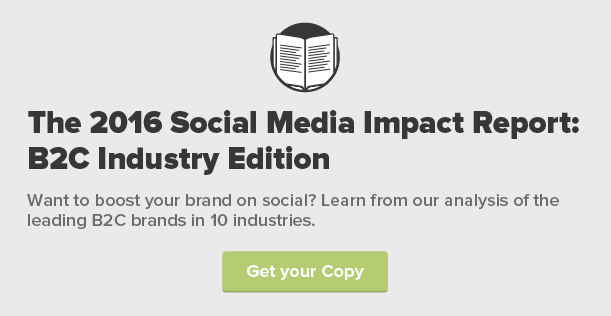The hospitality industry has seen a couple of major disruptions recently, most notably with the rise of services like AirBnB and Uber that provide new ways for customers to travel. Are these companies indicative of the industry as a whole, or are they outliers? And what can B2C marketers from any industry learn from their success on social media?
To answer these questions, let’s take a look at the data. We analyzed 350,000 posts from 213 brands across 10 B2C industries on five social media channels from January through October, 2015. Here are a few of the cues marketers can take from the most successful brands in the hospitality industry.
Hospitality brands know how to grow their audiences
Across the B2C landscape, brands in the hospitality sector have seen the highest social media audience growth relative to other industries, with 53.34% average follower growth in that timeframe on Twitter, Facebook, Instagram, Pinterest, and LinkedIn combined, all while their engagement levels are just middle-of-the-pack compared to the rest of the B2C industries.
AirBnB and Uber are the primary drivers of follower growth
Out of the 13 leading hospitality brands we examined, in both lodging and auto services, AirBnB and Uber accounted for 70.1% of total follower growth for this industry on Twitter, Facebook, LinkedIn, Instagram, and Pinterest. AirBnB alone saw a 113.3 % growth in total followers, concentrated on Facebook and Instagram, while Uber saw a 206.81% increase in followers, with a large portion of that growth focused on Facebook.
Large follower growth, but average engagement
Although brands in the hospitality industry experienced staggering audience growth, their engagement level is average compared to the other B2C industries we looked at.
Hospitality brands have their highest engagement on Instagram, with an average of 20.82 interactions per post per 1,000 followers. This is consistent with the other B2C industries we examined, which all had their highest levels of engagement on Instagram.
Taking a closer look at the how the hospitality industry performs on Instagram by subsector, it is clear that auto services brands, such as Uber and Enterprise, out-engage lodging brands, such as Airbnb and Marriott, with an average of 24.5 interactions per post per 1,000 followers versus an average of 18.1 interactions per post per 1,000 followers.
What can B2C marketers learn from AirBnB and Uber?
Both AirBnB and Uber were major disrupters for the hospitality industry, and accounted for a huge part of the sector’s social media audience growth in 2015. What kind of content were they posting that made such a huge impact, and what can B2C marketers from any industry learn from them? Let’s take a closer look at their most impactful posts on Facebook and Instagram, where both brands saw the largest audience growth and engagement.
Both Uber and AirBnB have posts with the greatest relative impact on Facebook. Both feature original, brand-produced videos that speak to human values and incorporate personal stories.
Uber’s top post announced new features for their service that would improve the driving experience for their deaf and hard-of-hearing partners. It features the personal story of one deaf Uber driver, and his experience with the company and the new features.
Airbnb’s top post—also a video—features a collection of personal stories around traveling as an LGBTQ person. The company uses the hashtag #HostWithPride, and focuses their message on the fact that they are an “open community where everyone is welcome to travel.”
On Instagram, both AirBnB and Uber focus on beautiful photos that inspire viewers to travel (and use their services when they do so).
AirBnB had the higher impact post, which features a gorgeous photo of a unique seashell house that is available for lodging, using a user-generated photo that they reposted.
Uber’s top post has a beautiful sunset shot of palm trees, with the message “Enjoy the ride,” and the hashtag #TakeMeThere.
B2C marketers can learn from these two industry disrupters’ success on social media by posting content that speaks to customers’ values and personalizes their connection to a brand, while incorporating appealing visuals that inspire followers to use their products and services.
Want to learn more about what works for other B2C industries and brands on social media? Check out our B2C Social Media Impact Report!








